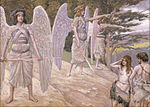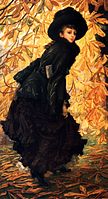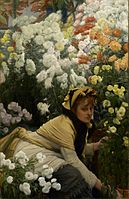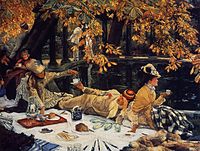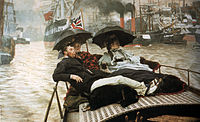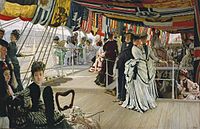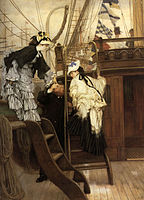James Tissot: Difference between revisions
| Line 15: | Line 15: | ||
[[Émile Péreire]] supplied Tissot's painting ''Walk in the Snow'' for the 1862 international exhibition in London; the next year three paintings by Tissot were displayed at the London gallery of [[Ernest Gambart]].<ref name=ODNB /> In about 1863, Tissot suddenly shifted his focus from the medieval style to the depiction of modern life through portraits. During this period, Tissot found himself held in high critical acclaim, quickly becoming a successful artist. Like contemporaries such as [[Alfred Stevens (painter)|Alfred Stevens]] and [[Claude Monet]], Tissot also explored ''japonisme'', including Japanese objects and costumes in his pictures. A portrait of Tissot by Degas from these years (Metropolitan Museum of Art, New York) shows him with a Japanese screen hanging on the wall.<ref>{{cite web|title=Portrait of James-Jacques-Joseph Tissot|url=http://www.metmuseum.org/works_of_art/collection_database/european_paintings/james_jacques_joseph_tissot_1836_1902_edgar_degas/objectview.aspx?page=1&sort=6&sortdir=asc&keyword=edgar%20degas&fp=1&dd1=11&dd2=0&vw=1&collID=11&OID=110000583&vT=1&hi=0&ov=0}}</ref> |
[[Émile Péreire]] supplied Tissot's painting ''Walk in the Snow'' for the 1862 international exhibition in London; the next year three paintings by Tissot were displayed at the London gallery of [[Ernest Gambart]].<ref name=ODNB /> In about 1863, Tissot suddenly shifted his focus from the medieval style to the depiction of modern life through portraits. During this period, Tissot found himself held in high critical acclaim, quickly becoming a successful artist. Like contemporaries such as [[Alfred Stevens (painter)|Alfred Stevens]] and [[Claude Monet]], Tissot also explored ''japonisme'', including Japanese objects and costumes in his pictures. A portrait of Tissot by Degas from these years (Metropolitan Museum of Art, New York) shows him with a Japanese screen hanging on the wall.<ref>{{cite web|title=Portrait of James-Jacques-Joseph Tissot|url=http://www.metmuseum.org/works_of_art/collection_database/european_paintings/james_jacques_joseph_tissot_1836_1902_edgar_degas/objectview.aspx?page=1&sort=6&sortdir=asc&keyword=edgar%20degas&fp=1&dd1=11&dd2=0&vw=1&collID=11&OID=110000583&vT=1&hi=0&ov=0}}</ref> |
||
Tissot fought in the [[Franco-Prussian War]] as part of the improvised defence of Paris, joining two companies of the [[Garde Nationale]] and later as part [[Paris Commune]]. Either because of the political associations caused by the latter, which he was believed to have joined to protect his own belongings, or simply because of better opportunities, he left Paris for London in 1871.<ref name=Misfeldt>{{citation |first=Willard E. |last=Misfeldt |title=Tissot, James |journal=Grove Art Online, Oxford Art Online |publisher=Oxford University Press |accessdate=5 July 2014 |url=http://www.oxfordartonline.com/subscriber/article/grove/art/T085236 |subscription=yes}}</ref> During this period, [[Francis Seymour Haden|Seymour Haden]] helped him with learning about etching.<ref>{{cite EB1911|wstitle=Tissot, James Joseph Jacques|volume=26|pages=1015-1016}}<ref> |
Tissot fought in the [[Franco-Prussian War]] as part of the improvised defence of Paris, joining two companies of the [[Garde Nationale]] and later as part [[Paris Commune]]. Either because of the political associations caused by the latter, which he was believed to have joined to protect his own belongings, or simply because of better opportunities, he left Paris for London in 1871.<ref name=Misfeldt>{{citation |first=Willard E. |last=Misfeldt |title=Tissot, James |journal=Grove Art Online, Oxford Art Online |publisher=Oxford University Press |accessdate=5 July 2014 |url=http://www.oxfordartonline.com/subscriber/article/grove/art/T085236 |subscription=yes}}</ref> During this period, [[Francis Seymour Haden|Seymour Haden]] helped him with learning about etching.<ref>{{cite EB1911|wstitle=Tissot, James Joseph Jacques|volume=26|pages=1015-1016}}</ref> |
||
Having already worked as a caricaturist for [[Thomas Gibson Bowles]], the owner of the magazine ''[[Vanity Fair (British magazine)|Vanity Fair]]'', as well as exhibited at the Royal Academy, Tissot arrived with established social and artistic connections in London. Bowles gave Tissot both a place to stay as well as a cartooning job for ''[[Vanity Fair (British magazine)|Vanity Fair]]''.<ref name=heilbrunn>[http://www.metmuseum.org/toah/works-of-art/1998.170. "James Tissot: Tea" (1998.170) In Heilbrunn Timeline of Art History . New York: The Metropolitan Museum of Art, 2000–.(December 2008)]</ref> |
Having already worked as a caricaturist for [[Thomas Gibson Bowles]], the owner of the magazine ''[[Vanity Fair (British magazine)|Vanity Fair]]'', as well as exhibited at the Royal Academy, Tissot arrived with established social and artistic connections in London. Bowles gave Tissot both a place to stay as well as a cartooning job for ''[[Vanity Fair (British magazine)|Vanity Fair]]''.<ref name=heilbrunn>[http://www.metmuseum.org/toah/works-of-art/1998.170. "James Tissot: Tea" (1998.170) In Heilbrunn Timeline of Art History . New York: The Metropolitan Museum of Art, 2000–.(December 2008)]</ref> |
||
[[Image:James Tissot - On the Thames.jpg|''On the Thames''|thumb|''On the Thames, 1882<ref>{{cite web |url=http://www.the-athenaeum.org/art/detail.php?ID=4953 |accessdate=5 July 2014 |title=On the Thames |publisher= The Athenaeum}}</ref>'']] |
[[Image:James Tissot - On the Thames.jpg|''On the Thames''|thumb|''On the Thames, 1882<ref>{{cite web |url=http://www.the-athenaeum.org/art/detail.php?ID=4953 |accessdate=5 July 2014 |title=On the Thames |publisher= The Athenaeum}}</ref>'']] |
||
Revision as of 22:55, 26 August 2014
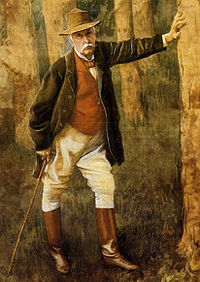
Jacques Joseph Tissot (15 October 1836 – 8 August 1902), who became known as James Tissot by 1854, was a French painter and illustrator. He left Paris for London in 1871. He was a successful painter of Paris society before moving to London in 1871. He became famous as a genre painter of fashionably dressed women shown in various scenes of everyday life. He also made paintings illustrating the Bible.
Early life
Tissot was born in the port town of Nantes, France, Europe and spent his early childhood there. His father, Marcel Théodore Tissot, was a successful drapery merchant. His mother, Marie Durand, assisted her husband in the family business and designed hats. A devout Catholic, Tissot's mother instilled pious devotion in the future artist from a very young age. Tissot's youth spent in Nantes likely contributed to his frequent depiction of shipping vessels and boats in his later works. The involvement of his parents in the fashion industry is believed to have been an influence on his painting style, as he depicted women's clothing in fine detail. By the time Tissot was 17, he knew he wanted to pursue painting as a career. His father opposed this preferring his son to follow a business profession but he gained his mother's support for his chosen vocation. Around this time, he began adopting the name of James and by 1854 was commonly known as James Tissot, perhaps because of his increasing interest in everything English.[1]
Early career
In 1856 or 1857, Tissot travelled to Paris to pursue an education in art. While staying with a friend of his mother, painter Elie Delaunay, Tissot enrolled at the Ecole des Beaux-Arts to study in the studios of Hippolyte Flandrin and Louis Lamothe,[2] both successful Lyonnaise painters who came to Paris to study under Ingres. Lamothe provided a majority of Tissot's studio education, while he studied on his own as did most other artists of the time, by copying works at the Louvre. Around this time, Tissot also made the acquaintance of James McNeill Whistler as well as Edgar Degas (who had also been a student of Lamothe and a friend of Delaunay) and Édouard Manet.[1]
In 1859, Tissot exhibited in the Paris Salon for the first time. He showed five paintings of scenes from the Middle Ages, many depicting scenes from Goethe's Faust.[3] These works show the influence over his work of the Belgian painter Henri Leys (Jan August Hendrik Leys), whom Tissot had met in Antwerp earlier that same year. Other influences include the works of the German painters Peter von Cornelius and Moritz Retzsch. When Tissot had only exhibited at the Salon once and before he had been awarded a medal, the French government paid 5,000 francs for his depiction of The Meeting of Faust and Marguerite in 1860, with the painting being exhibited at the Salon the following year together with a portrait and other paintings.[1]
Mature career

Émile Péreire supplied Tissot's painting Walk in the Snow for the 1862 international exhibition in London; the next year three paintings by Tissot were displayed at the London gallery of Ernest Gambart.[1] In about 1863, Tissot suddenly shifted his focus from the medieval style to the depiction of modern life through portraits. During this period, Tissot found himself held in high critical acclaim, quickly becoming a successful artist. Like contemporaries such as Alfred Stevens and Claude Monet, Tissot also explored japonisme, including Japanese objects and costumes in his pictures. A portrait of Tissot by Degas from these years (Metropolitan Museum of Art, New York) shows him with a Japanese screen hanging on the wall.[4]
Tissot fought in the Franco-Prussian War as part of the improvised defence of Paris, joining two companies of the Garde Nationale and later as part Paris Commune. Either because of the political associations caused by the latter, which he was believed to have joined to protect his own belongings, or simply because of better opportunities, he left Paris for London in 1871.[5] During this period, Seymour Haden helped him with learning about etching.[6] Having already worked as a caricaturist for Thomas Gibson Bowles, the owner of the magazine Vanity Fair, as well as exhibited at the Royal Academy, Tissot arrived with established social and artistic connections in London. Bowles gave Tissot both a place to stay as well as a cartooning job for Vanity Fair.[7]

He quickly developed his reputation as a painter of elegantly dressed women shown in scenes of fashionable life. By 1872, Tissot was able to purchase his own home in St John's Wood, an area of London very popular with artists at the time. According to The Oxford Dictionary of Art and Artists, "in 1874 Edmond de Goncourt wrote sarcastically that he had 'a studio with a waiting room where, at all times, there is iced champagne at the disposal of visitors'".[9] He gained membership of The Arts Club in 1873.[1]
Paintings by Tissot appealed greatly to wealthy British industrialists during the second half of the 19th-century and during 1872 he earned 94,515 francs, an income normally only enjoyed by those in the echeleons of the upper classes.[1]
In 1874, Degas asked him to join them in the first exhibition organized by the artists we call the Impressionists, but Tissot refused. He continued to be close to the artists however. Berthe Morisot visited him in London in 1874 and he travelled to Venice with Édouard Manet at about the same time. He regularly saw Whistler, who influenced Tissot's Thames scenes.[1]
In 1875-6, Tissot met a divorcee named Mrs. Kathleen Newton, who became the painter's companion and frequent model. He composed an etching of her in 1876 entitled Portrait of Mrs N., more commonly daubed La frileuse.[1] She gave birth to a son, Cecil George Newton in 1876, who is believed to be Tissot's son. She moved into Tissot's household in St. John's Wood in 1876 and stayed there until her death in the late stages of consumption in 1882. Tissot would frequently refer to these years with Newton as the happiest of his life, a time when he was able to live out his dream of a family life.[5]
After Kathleen Newton's death, Tissot returned to Paris. A major exhibition of his work took place in 1885 at the Galerie Sedelmeyer, where he showed 15 large paintings in a series called La Femme à Paris. Unlike the genre scenes of fashionable women he painted in London, these paintings represent different types and classes of women, shown in their professional and social contexts.[1] The works suggest the influence of Japanese prints in their use of unexpected angles and framing, as well as a monumental context shown in the size of the canvases.[10] This was the influence of Japanese art, fashion and aesthetics on Western culture.[11][12]
Late career


In 1885, Tissot experienced a re-conversion to Catholicism, which led him to spend the rest of his life illustrating the Bible. Many of his artist friends were skeptical about his conversion, as it conveniently coincided with the French Catholic revival, a reaction against the secular attitude of the French Third Republic. At a time when French artists were still working in impressionism, pointilism, and heavy oil washes, Tissot was moving toward realism in his watercolors. To assist in his completion of biblical illustrations, Tissot traveled to the Middle East in 1886, 1889, and 1896 to make studies of the landscape and people. His series of 365 gouache illustrations showing the life of Christ were shown to critical acclaim and enthusiastic audiences in Paris (1894–5), London (1896) and New York (1898–9), before being bought by the Brooklyn Museum in 1900.[13] They were published in a French edition in 1896–7 and in an English one in 1897–8, bringing Tissot vast wealth and fame. During July 1894, Tissot was awarded the Légion d'honneur, France's most prestigious medal.[1] Tissot spent the last years of his life working on paintings of subjects from the Old Testament (Jewish Museum, New York).[14] Although he never completed the series, he exhibited 80 of them in Paris in 1901 and engravings after them were published in 1904.[5]
- Religious paintings
-
Adam and Eve Driven From Paradise, between 1896 and 1902
-
The Ark Passes Over the Jordan, between 1896 and 1902
-
The Creation, Jewish Museum (New York), 1896 and 1902
-
The Seven Trumpets of Jericho 1896 and 1902
Death and legacy
Tissot died suddenly in Doubs, France on 8 August 1902, while living in the Château de Buillon, a former abbey which he had inherited from his father in 1888. His grave is in the chapel sited within the grounds of the chateau.[1][5] Widespread use of of his illustrations in literature and slides continued after his death with The Life of Christ and The Old Testament becoming the "definitive Bible images". His images have provided a foundation for contemporary films such as Raiders of the Lost Ark and The Age of Innocence. In the first half of the 20th-century there was a re-kindling of interest in his portraits of well attired ladies and some fifty years later these were achieving record prices.[1]
See also
Gallery
-
Hide & Seek, 1877
-
The Ball
-
October
-
Gentleman in a Railway Carriage, 1872
-
Chrysanthemums
-
Seaside
-
Lilacs, 1875
-
The Fireplace
-
Holiday, 1876
-
The Gallery of H.M.S. 'Calcutta' (Portsmouth), 1877
-
The Captain's Daughter, 1873
-
Kathleen Newton In An Armchair
-
The Garden Bench, 1882
-
Bad News
-
Young Lady in a Boat
-
A Passing Storm, 1876
-
The Thames , 1867
-
Captain Frederick Gustavus Burnaby
-
La partie carrée
-
Ball on Shipboard, 1874
-
La Japonaise au bain
-
Still on Top
-
At the Rifle Range
-
Women of Paris - The Circus Lover
-
Boarding the Yacht, 1873
-
The Bridesmaid, 1883-83
-
Young Ladies Looking at Japanese Objects
-
A Little Nimrod
References and sources
References
- ^ a b c d e f g h i j k l Matyjaszkiewicz, Krystyna (2011), "Tissot, Jacques Joseph (1836–1902)", Oxford Dictionary of National Biography, Oxford University Press, retrieved 5 July 2014
{{citation}}: Unknown parameter|subscription=ignored (|url-access=suggested) (help) - ^ Alley, Ronald. "James Tissot 1836-1902", Catalogue of the Tate Gallery's Collection of Modern Art other than Works by British Artists, Tate Gallery and Sotheby Parke-Bernet, London 1981, p.718
- ^ Kleinschmidt, Beda. "James Tissot." The Catholic Encyclopedia. Vol. 14. New York: Robert Appleton Company, 1912. 27 Dec. 2013
- ^ "Portrait of James-Jacques-Joseph Tissot".
- ^ a b c d Misfeldt, Willard E., "Tissot, James", Grove Art Online, Oxford Art Online, Oxford University Press, retrieved 5 July 2014
{{citation}}: Unknown parameter|subscription=ignored (|url-access=suggested) (help) - ^ Chisholm, Hugh, ed. (1911). . Encyclopædia Britannica. Vol. 26 (11th ed.). Cambridge University Press. pp. 1015–1016.
- ^ "James Tissot: Tea" (1998.170) In Heilbrunn Timeline of Art History . New York: The Metropolitan Museum of Art, 2000–.(December 2008)
- ^ "On the Thames". The Athenaeum. Retrieved 5 July 2014.
- ^ Chilvers, Ian, ed. (2009), "Tissot, James", The Oxford Dictionary of Art and Artists, Oxford University Press
- ^ By Jules Claretie in his book L'Art français en 1872 and by Philippe Burty (1830–1890) in Japonisme III: La Renaissance littéraire et artistique
- ^ "Définition japonisme et traduction". Le Dictionnaire. Retrieved 5 June 2014.
- ^ "Japonism". Dictionary.com. Retrieved 5 June 2014.
- ^ Brooklyn Museum. "James Tissot". Retrieved 3 May 2011.
- ^ Jewish Museum. "James Tissot".
Sources
- Biography of Tissot with recent information on Kathleen Newton
- Misfeldt, Willard E. "Tissot, James [Jacques-Joseph]" in Oxford Art Online.
- Wentworth, Michael. "James Tissot." Oxford: Clarendon Press, 1984. Print
- Wood, Christopher. "Tissot: Life and Work of Jacques Joseph Tissot 1836-1902." London: Weidenfeld and Nicolson, 1986. Print.
- This article incorporates text from a publication now in the public domain: Chisholm, Hugh, ed. (1911). Encyclopædia Britannica (11th ed.). Cambridge University Press.
{{cite encyclopedia}}: Missing or empty|title=(help)
External links
- 209 works by James Tissot at www.JamesTissot.org
- James Tissot: The Life Of Christ. Exhibition at Brooklyn Museum 2009
- Commentary on Tissot's etching of Kathleen Newton
- Commentary on a portrait of Mrs. Newton
- Zimmer, Bill (31 October 1999). "Art; Love and History, Lavishly Elegant". New York Times. Retrieved 6 August 2008.
- Biblical art by James Tissot
- Degas: The Artist's Mind, exhibition catalog from The Metropolitan Museum of Art fully available online as PDF, which contains material on James Tissot (see index)

